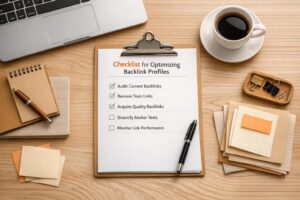Last Updated on August 11, 2025 by Becky Halls
Internal links are a powerful tool for improving your website’s performance in search rankings. They help distribute authority across your pages, guide search engines in understanding your site’s structure, and enhance the user experience by connecting related content.
Key Takeaways:
- Domain Authority (DA): A metric by Moz that predicts how well a site may rank, influenced by external and internal links.
- Internal Links: Links between pages on the same domain that pass authority and help search engines map your site.
- Benefits:
- Boosts visibility for new or low-authority pages.
- Helps search engines crawl and index pages efficiently.
- Increases rankings for linked pages by sharing “link equity.”
- Improves navigation and user engagement.
Quick Tips:
- Link from high-authority pages (e.g., your homepage) to newer or less-visited pages.
- Use keyword-rich, descriptive anchor text for better context.
- Place links naturally within content, avoiding overuse in sidebars or footers.
- Regularly audit and update your internal links to fix broken or outdated ones.
Bottom line: By strategically placing internal links, you can strengthen your site’s authority, boost rankings, and improve user experience – all without relying on external outreach.
38 Points On-Page SEO Checklist (2023 Update) | Kai Cromwell
Research Findings: How Internal Linking Affects Domain Authority
A well-organized internal linking strategy plays an important role in improving SEO and increasing domain authority. Research suggests that using a hierarchical linking structure can help distribute link equity across a website, which may lead to better search rankings over time. These insights provide a foundation for understanding how internal links contribute to authority distribution.
How Internal Linking Impacts Rankings
Research indicates that websites with carefully planned internal linking structures often see noticeable improvements in performance. For instance, studies have shown that pages linked from high-authority sections of a site are more likely to rank well for their targeted keywords. Additionally, maintaining a hierarchical linking structure appears to help sustain domain authority over the long term.
The Role of Anchor Text in Authority Flow
When it comes to anchor text, research highlights the importance of optimization. Internal links with keyword-rich anchor text – whether it’s exact-match, partial-match, or branded terms – can improve the flow of authority between pages. Evidence also suggests that contextual links placed within the main body of content tend to pass more authority compared to links found in navigational elements like headers or footers.
Limitations and Challenges in Internal Linking Studies
While internal linking clearly offers benefits, isolating its impact from other SEO efforts can be tricky. Websites often implement multiple improvements simultaneously, such as upgrading content, enhancing page speed, or refining external link strategies, all of which can influence domain authority. Furthermore, variations in study methods, sample sizes, and the ever-changing nature of search engine algorithms mean that the most effective internal linking approach can differ depending on the industry or specific website context.
How Internal Links Influence Domain Authority
Internal links play a crucial role in boosting domain authority by distributing ranking value and clarifying your site’s structure. When you create these links, you essentially build pathways that spread authority across your website while helping search engines understand how your content connects. Let’s dive into how this works, starting with link equity.
How Link Equity Works
Link equity, sometimes called “authority”, is the value passed from one page to another through hyperlinks. Think of it as a kind of currency flowing throughout your website. When a high-authority page links to another, it shares some of its value, boosting the destination page’s authority.
This process is modeled by Google’s PageRank algorithm, which views the web as a “random surfer” navigating from page to page via links. Each internal link acts like a vote, signaling to search engines that the linked page contains worthwhile and related content.
For example, when your homepage – a high-authority page – links to a new blog post, it transfers some of its authority to that post. This helps the new content rank faster and provides a boost to older pages buried deep within your site.
It’s important to note that link equity doesn’t generate new authority; it redistributes the authority your site already has. This means your internal linking strategy should focus on directing authority from your strongest pages to those that need extra support. Pages with more internal links pointing to them not only receive more authority but are also crawled more frequently by search engines.
Internal Links and Search Engine Crawling
Search engines depend on internal links to discover and index pages. Without these links, some pages – known as orphan pages – may remain invisible to search engines. Internal links act as a roadmap, guiding search engine bots through your site and highlighting which pages are the most important.
The structure of your internal links also influences how often search engines crawl your pages. Pages with more internal links tend to get crawled more frequently, meaning updates or new content on these pages are indexed faster. This underscores the connection between your linking strategy and how quickly search engines recognize changes on your site.
Additionally, internal links help search engines understand the relationships between your content and identify topical clusters. When you consistently link related articles, you’re signaling that your site has in-depth knowledge in specific areas. This can strengthen your site’s authority on those topics, improving rankings for related search queries across your domain.
Best Practices for Link Placement and Anchor Text
The effectiveness of internal links doesn’t stop at discovery. Placement and anchor text also play a big role in how much value these links provide. Links embedded in the main content area carry more weight than those in sidebars, navigation menus, or footers. Search engines prioritize contextual links that appear naturally within relevant content, especially those placed near the top of the page.
Anchor text – the clickable text of a link – is another critical factor. It tells search engines what the linked page is about and helps establish its relevance. Using descriptive, keyword-rich anchor text can improve the target page’s ranking for those specific terms. However, moderation is key. Overusing exact-match anchor text can appear manipulative and harm your SEO efforts.
A well-thought-out internal linking strategy can significantly enhance search performance. The key is to focus on strategic placement rather than inserting links randomly. For instance, linking from high-authority pages like your homepage or cornerstone content can maximize the transfer of link equity. When these links use relevant anchor text and are placed within meaningful content, they can greatly improve the visibility and rankings of your target pages.
Finally, avoid over-automating your internal linking strategy. Automated systems often create irrelevant or spammy links, which can hurt both user experience and SEO. A manual, strategic approach ensures your internal links benefit both search engines and your audience, setting the stage for long-term domain authority growth.
sbb-itb-88880ed
Practical Methods for Optimizing Internal Links
Optimizing internal links isn’t just about adding random links across your site – it’s about strategy, using the right tools, and keeping everything under review. The goal? To create a well-structured system that improves how link equity flows through your site while ensuring both users and search engines can easily navigate your content.
Building a Clear Internal Linking Structure
An effective internal linking strategy starts with a solid site architecture. A hub-and-spoke structure works well here, connecting your main cornerstone content to related pages.
First, identify your cornerstone content – these are your most important, in-depth pages that you want to rank the highest. These pages should receive the bulk of your internal links. For example, link related blog posts or subcategories back to cornerstone pages to strengthen their authority.
Another useful approach is topic clusters, where you group content around key themes. A pillar page acts as the central hub, linking to related cluster content, which in turn links back to the pillar page. This setup not only organizes your site logically but also signals to search engines that you’re an expert on specific topics, potentially boosting rankings for all connected pages.
Don’t neglect the deeper pages on your site – those buried more than three clicks away from the homepage. Linking to these pages can increase their visibility and authority.
Using Tools for Internal Link Analysis
Once you’ve structured your internal links, tools can help you refine and optimize your strategy.
- Google Search Console: Use the “Links” report to see which pages have the most internal links. This helps you understand which content already has strong internal link support and where you might need to focus.
- Screaming Frog SEO Spider: This tool crawls your site to reveal patterns in internal linking, broken links, and pages with either too few or too many links. It can also identify orphan pages – those without any internal links – and offers visualizations of your site’s link structure.
- 3Way.Social: While primarily used for external link building, this platform’s AI-driven analysis can provide insights that complement your internal linking efforts, such as identifying areas for better link distribution.
- Ahrefs Site Audit and SEMrush Site Audit: Both tools analyze your internal link profiles, flagging pages with weak link support and suggesting improvements. They also track changes over time, helping you measure the impact of your adjustments.
Monitoring and Adjusting Internal Links
After setting up and analyzing your internal link structure, the work doesn’t stop there. Regular monitoring and updates are essential to keep your links effective.
- Audit and fix broken links: Broken links can hurt user experience and waste link equity. Make sure to address them promptly.
- Track performance metrics: Use tools like Google Analytics to monitor key metrics such as organic traffic to pages with new internal links, session duration, and keyword rankings. This will help you gauge the impact of your efforts.
- Keep links fresh: As you add new content, update your internal links to reflect it. Adjust links to highlight seasonal or trending content when necessary.
- Remove outdated links: If a linked page no longer exists or has become irrelevant, remove or update the link. Make sure anchor text stays relevant when page content changes.
Consistency is what makes internal linking strategies thrive. By regularly reviewing, updating, and improving your internal links, you’ll create a system that not only enhances user experience but also strengthens your site’s authority over time.
Conclusion: Internal Linking’s Role in Domain Authority Growth
Internal linking isn’t just a technical SEO move – it’s a cornerstone of building domain authority and improving rankings over time. Research shows that when done thoughtfully, internal links distribute link equity, enhance crawlability, and help search engines understand how your content connects.
By using strategies like hub-and-spoke models, topic clusters, and consistent anchor text, internal linking strengthens your site’s authority. It ensures link equity flows to pages that need a boost while reinforcing the importance of your cornerstone content. This strategic approach not only helps individual pages rank better but also solidifies your site’s overall structure.
What makes internal linking stand out is its lasting impact. Unlike external link-building efforts that often require constant outreach, internal links keep delivering value long after they’re implemented. Every new piece of content becomes a chance to strengthen your site’s existing pages, while every well-placed link helps search engines grasp your expertise in specific topics.
To make the most of internal linking, you need a clear site structure, regular audits, and performance tracking. These steps ensure your links remain effective as your site grows, keeping your content fresh and relevant. Over time, this ongoing effort builds a stronger foundation for better rankings.
For even greater results, consider integrating tools like 3Way.Social to complement your internal linking strategy. While internal links lay the groundwork, high-quality external backlinks from trusted sources can give your domain authority an extra push. Together, these tactics create a balanced approach to improving your site’s authority and visibility.
FAQs
What is a hub-and-spoke internal linking structure, and how can I use it to improve my website’s domain authority?
A hub-and-spoke internal linking structure is a method where a central hub page focuses on a broad topic and connects to spoke pages that dive into specific subtopics. Here’s how to use it effectively:
- Pick a hub page that acts as the main resource for your primary topic.
- Develop spoke pages with detailed, high-quality content on related subtopics.
- Link thoughtfully, ensuring spoke pages link back to the hub while also connecting relevant spokes to each other.
This setup helps search engines grasp the organization of your content, makes crawling easier, and spreads link equity across your site. The result? Better rankings and stronger domain authority.
What are the best practices for using anchor text in internal links to boost SEO?
To get the most out of your SEO efforts, anchor text in internal links should be specific, relevant, and to the point. Incorporate keyword-focused phrases that genuinely reflect the content of the linked page. However, don’t rely too heavily on exact match keywords, as this can come across as keyword stuffing. Instead, mix things up to keep the anchor text natural and user-friendly.
Avoid using vague terms like “click here” or “learn more.” Instead, aim for concise anchor text – preferably five words or fewer. Well-optimized anchor text not only helps search engines grasp the context of your linked pages but can also boost your site’s domain authority and search rankings.
How often should I review and update my internal links to boost domain authority?
To keep your internal links working effectively and in line with your SEO goals, it’s smart to review and update them every 3 to 6 months. If you manage a larger site or one that’s updated frequently, you might find it helpful to conduct audits more often – perhaps every quarter or even monthly.
These regular audits ensure your links stay relevant, are well-placed, and actively contribute to boosting your site’s domain authority over time. Tweaking your strategy to reflect content changes or shifts in user behavior can have a noticeable effect on your SEO results.



